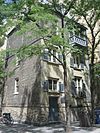Henry Scadding
Anglican clergyman and writer | |
|---|---|
| Parent | (father) |
Henry Scadding (July 29, 1813 – May 6, 1901) was a Canadian writer and
Life and career
Scadding was born at
Scadding was the first boy enrolled at Upper Canada College and now has a Day Boy House named after him there, called
In 1847, Scadding became the
Scadding wrote many books, including the Memorial of the Reverend William Honywood Riply (1849), Shakespeare the Seer—the Interpreter (1864), Truth's Resurrection (1865), Christian Pantheism (1865), Toronto of Old (1873),[2] The Four Decades of York, Upper Canada (1884) and A History of the Old French Fort at Toronto (1887). In his writings, Scadding was principally interested in history and religious themes.
He also edited the Canadian Journal of Science, Literature, and History from 1868 to 1878. Scadding was a co-founder and the first president of the York Pioneers, a Toronto-based historical society that preserved Scadding Cabin, which had been built by his father in the early days of the town of York.
Works
| Building | Year Completed | Builder | Style | Source | Location | Image |
|---|---|---|---|---|---|---|
| Henry Scadding House | 1862 | Henry Scadding | 6 Trinity Square, Toronto | 
|
See also
References
- ^ "Scadding, Henry (SCDN833H)". A Cambridge Alumni Database. University of Cambridge.
- Torontoist. Retrieved 2020-04-30.
His best known book is Toronto of Old (1873), which discusses the history of European contact and settlement in Toronto, starting with the French in the 17th century.
External links
| Archives at | ||||||
|---|---|---|---|---|---|---|
|
||||||
| How to use archival material |
- Works by Henry Scadding at Faded Page (Canada)
- Works by Henry Scadding at Project Gutenberg
- Works by or about Henry Scadding at Internet Archive
- "Henry Scadding". Dictionary of Canadian Biography (online ed.). University of Toronto Press. 1979–2016.
- Bibliographic directory from Project Canterbury
